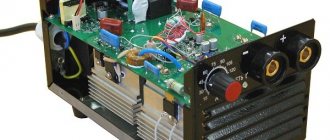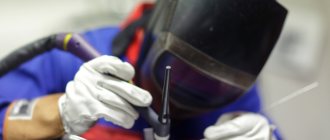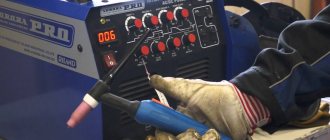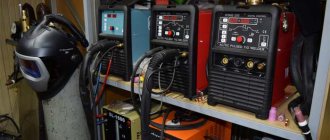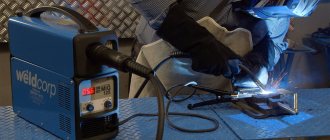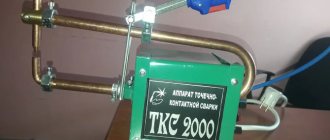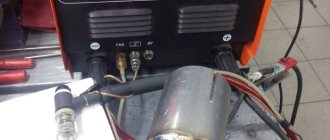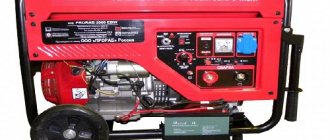There are a wide variety of types and types of welding. But they all have one thing in common - the need to use an electric arc, without which the formation of a seam is impossible. And among the wide variety, MIG/MAG welding using gas is one of the most popular.
This type of welding is simple and easy to use, it is suitable for both a novice welder and an experienced welder. Using instant welding, you can easily weld different types of metals, with different thicknesses and any complexity of seams. In this article we will tell you what MIG is and what are the features of shielded gas welding.
Definition
MIG/MAG welding (also known as electric arc welding in a gas environment, arc welding in a shielding gas environment, also known as magic and mig welding, GMAW) is semi-automatic, manual and automatic welding in a shielding gas environment using the fusion method (GMAW stands for “Gas metal” Arc welding").
Below is a schematic diagram of TIG (tig welding) and MIG/MAG welding. You can compare them and understand what the differences are.
MIG/MAG welding is only possible with direct current, but the polarity can be either direct or reverse. You may have noticed that in addition to MIG, we also use the abbreviation MAG in this article. MAG is also semi-automatic welding, only using carbon dioxide.
With magic welding everything is the same as with mig. Only instead of, say, argon, carbon dioxide is used. It's much cheaper. But with the help of such welding, only parts made of alloy and low-alloy steels can be connected. This is a limitation. So choose professional semi-automatic machines that can work in both MAG and MIG modes. Such devices give you more possibilities; you can use filler wire of any diameter in your work.
Now that we know what mig is, it's time to find out what equipment will be optimal for this method.
Peculiarities
Semi-automatic MIG MAG welding is effective only if all rules are followed and all features are taken into account. We will talk about some of them further.
Selecting a device
First, a little about the equipment. MIG MAG welding machines perform specific tasks, so you need to choose a welder with special attention. First of all, pay attention to what current the device operates on: direct or alternating. We recommend purchasing a DC device and installing reverse polarity when performing work.
A semi-automatic welding machine using alternating current or direct current and straight polarity is not capable of generating a stable welding arc. Under such conditions, it is difficult to form a weld because the filler wire melts too quickly and the metal spatters.
Also pay attention to additional functionality. Many MIG/MAG welding machines can also perform MMA or MMA and TIG welding. Such welders are universal and significantly increase your capabilities when carrying out work. You don't need to have several different devices when all the functions are in one.
Selecting consumables
Now about consumables. First about the wire. Its diameter is selected based on the thickness of the metal you are going to weld. The composition of the wire must be identical to the composition of the base metal. Copper wire cannot be used for welding stainless steel. This is a grave mistake.
As for the shielding gas, everything is not as complicated as it might seem at first glance. You can use inert, active gas or gas mixtures. We will give several recommendations regarding the choice of shielding gas when welding various metals.
For welding non-ferrous metal and its alloys, as well as non-ferrous metal-based materials, it is best to use inert gas. This can be helium, argon or gas mixtures of argon and helium in various proportions. If you are boiling copper and cobalt, use nitrogen gas. When working with various types, it has become better to use carbon dioxide (carbon dioxide). But keep in mind that in this case the wire must contain an increased amount of silicon and manganese.
Experienced welders also use mixtures of inert and active gases to improve arc stability and reduce metal spatter. This is a very specific topic that comes with experience. So in this article we will not touch on the topic of a mixture of inert and active gas.
Seam formation
When MIG/MAG welding, it's not just the welding machine and consumables that are important, but also how you form the weld. As we already wrote above, with this welding method, the seam is formed thanks to molten metal and molten wire. Therefore, the shape of the finished weld bead depends on how you transfer the molten wire into the weld pool.
Equipment and components
So, for work we need a standard semi-automatic machine. A set of welding equipment consists of a semi-automatic machine, a transformer (generating current), gas (a reducer must be attached to the cylinder to regulate the pressure), various hoses and cables, a gas torch equipped with an additional filler wire supply system and a feed mechanism.
MIG welding is essentially the same as gas shielded consumable electrode welding. Only instead of an electrode, a filler wire is used here. Most often the wire is made of aluminum. We recommend choosing wire made from the same material that you are going to weld.
The wire is wound onto a drum and automatically fed into the welding zone. The feed speed depends on the wire diameter and the current setting you set. All you have to do is point the torch at the welding zone and press the button.
The wire will begin to feed into the welding zone immediately after the arc is ignited. At the same time, the gas will begin to blow over the weld pool, preventing metal oxidation and the formation of defects. Drawing analogies with other types of welding, in our case the gas plays the role of a coated electrode, as in standard MMA welding. Only here the gas is supplied from the outside, and in MMA welding it is formed when the electrode melts.
general information
MIG/MAG welding is a type of arc welding that is performed using a consumable filler wire in a shielding gas environment. The gas can be either active or inert. As you understand, this method of joining metals is significantly different from MMA welding (manual arc welding). Therefore, for these purposes you need to use a special semi-automatic welding machine.
The MIG/MAG welding machine is equipped with a feed mechanism into which the filler wire is inserted. Also, a semi-automatic MIG or MAG machine must be used in conjunction with a torch through which protective gas is supplied.
Let's take a closer look at this welding technology to better understand its essence. In MIG/MAG welding, the welding arc burns between the end of the filler wire and the surface of the metal being welded. The filler wire is continuously fed into the welding zone. Due to the heat emanating from the welding arc, the metal and filler wire begin to melt. A weld pool is formed where the base metal and molten wire are mixed.
Let's not forget about gas. It is also continuously supplied to the welding zone throughout the entire welding process. It is thanks to the gas that it is possible to avoid the penetration of oxygen into the welding zone. Therefore, metal oxidation is excluded.
Advantages and disadvantages
The MIG welder is often criticized for being bulky. You can’t just hang it on your shoulder; you’ll have to carry a huge gas cylinder and other components with you. You will not be able to quickly move from one point to another unless you install the entire set of equipment on a special cart.
But, despite this, instant welding has many advantages that more than offset the disadvantages. For example, during operation no dangerous fumes are emitted, the arc is quite easy to ignite (beginners will appreciate this plus), the wire is consumed very economically, and it is possible to weld almost any metal of any thickness.
Equipment used
The MIG semi-automatic machine consists of several main parts:
- current generator (transformer or inverter);
- a gas cylinder equipped with a reducer;
- hoses and cables:
- torches with wire feed system;
- wire feeder.
The role of a consumable electrode is performed by a special wire made of aluminum, steel or other materials, which is wound on a drum and fed into the welding zone automatically. The feed speed is proportional to its diameter and welding current.
The welder just needs to bring the torch into the welding zone and press the handle. When an arc occurs, the electric motor feeds the wire to the seam, and gas under pressure blows through the bath and prevents atmospheric gases from reaching the hot metal, which can oxidize it.
In this case, the inert gas performs the functions of covering a conventional electrode during MMA welding, only the protective atmosphere is supplied from the outside in a ready-made form, and is not formed by burning the coating materials surrounding the steel rod. Semi-automatic MIG welding is sometimes criticized for being somewhat bulky - a cylinder, a drum with wire, an inverter or a generator actually somewhat reduce its mobility. But at the same time it has a number of very important advantages:
- no toxic fumes are released during welding;
- it is very easy to ignite and maintain the arc (especially on inverters);
- wire consumption is minimized;
- You can weld very thin sheets of metal.
MIG/MAG welding works with direct current of direct or reverse polarity, as well as with sinusoidal current, depending on the characteristics of the metal being welded.
MAG MIG welding machine from AliExpress from 15,630 rubles →
The second type of semi-automatic welding is MAG (metal active gas welding) in a carbon dioxide atmosphere. It is produced on the same principle as MIG, but carbon dioxide is pumped into the cylinder, which is cheaper than inert. But its use imposes some restrictions - only low-alloy and alloy steels can be welded. But in terms of ease of use and breadth of functions, this type of welding is not inferior to MIG.
As a rule, professional semi-automatic welding MIG/MAG is designed to operate in two modes: both with inert gas and with carbon dioxide. It has wide current adjustment capabilities and the ability to work with welding wire of any diameter. The most commonly used wire is 0.5-4 mm; its choice depends on the thickness of the material and its properties.
Welding technology
Set the voltage to no more than 30V. The optimal value is from 18 to 30V, selected individually depending on your welding machine. Also note that in most cases, your semi-automatic welding machine will not have the function of manually adjusting the wire feed speed. This is not a breakdown or a defect, it is necessary to stabilize the arc.
For professionals, the inability to manually adjust the wire feed can be a problem, but believe me, it is very convenient. The feed mechanism is complex and technologically advanced; it relieves the welder of unnecessary manipulations and allows him to concentrate on work.
For example, the wire feed mechanism in a semi-automatic machine for MIG/MAG welding itself determines at what moments it is necessary to slow down or, conversely, speed up the feed so that the arc is more stable. The mechanism also protects the wire from melting into the burner. With this mechanism, the wire will never stick to the torch or to the connection when first fed. Also, thanks to the automatic feed mechanism, pulse welding can be performed.
In most cases, MAG/MIG welding will be done using reverse polarity and constant current, as these settings are most optimal. But if you have enough experience and are willing to experiment, you can install straight polarity and alternating current.
Also, more or less advanced machines have several operating modes. Let's look at them in more detail:
- "Short Arc" mode. Suitable for thin metal applications where current less than 200 amps is used.
- Spray Arc mode. This is the most universal mode, used when working with wire with diameters greater than 1 millimeter.
- Pulse Arc mode. Used when working with large diameter wire. Ideal for welding steel and aluminum.
- Pulse on Pulse Arc mode. Suitable for creating extremely aesthetic seams.
MAG welding
The second type of semi-automatic welding of metals is MAG welding, which is performed in an atmosphere of active gas, for example carbon dioxide. The welding principle itself is identical to the MIG method, but carbon dioxide is pumped into the cylinder, the cost of which is lower than inert gas. The use of this type of welding has slight limitations - only alloy and low-alloy steels can be welded using the MAG method. In terms of ease of operation and breadth of functions, MAG welding is in no way inferior to MIG welding.
Semi-automatic MIG/MAG machines intended for professional use often operate in both modes - both with carbon dioxide and with inert. Such welding equipment allows the welder to regulate the current and can work with wire of any diameter. The most commonly used wire is 0.5-4.0 mm in diameter, but its choice in each individual case depends on the thickness of the metal and its chemical properties.
MAG welding mode in carbon dioxide environment
| Thickness of welded edge, mm | 6.0-8.0 | 4.0-5.0 | 3.0 | 2.0-2.5 | 1.5-2.0 | 1.5 |
| Electrode diameter, mm | 1.2-1.6 | 1.2-1.6 | 1.2-1.4 | 1.0-1.2 | 1.0-1.2 | 0.8-1.0 |
| Current strength, A | 200-300 | 200-300 | 200-300 | 130-170 | 130-150 | 95-125 |
| Active gas consumption, liters/min. | 12-18 | 11-16 | 8-12 | 6-7 | 6-7 | 6-7 |
| Automatic wire feed speed, m/hour | 500-700 | 500-700 | 350-500 | 150-250 | 150-220 | 150-220 |
| Open wire length, mm | 10-20 | 10-20 | 10-13 | 10-13 | 10-13 | 6-10 |
Depending on the model of the semi-automatic machine, welding occurs at idle voltage of 19-30 V. The vast majority of semi-professional and household semi-automatic machines do not have the ability to adjust the supply speed of the working current and voltage. This approach ensures automatic stabilization of the electric arc (auto-correction).
Semiautomatic machines for MIG-MAG welding
All semi-automatic MIG-MAG welding machines on the market today consist of several parts:
- Current generator – inverter or transformer.
- Gas cylinder equipped with a reducer.
- Cables, hoses.
- Torch including wire feed system.
- Wire feeding mechanism.
The role of the electrode that melts is a special wire (aluminum or steel, sometimes it can be other materials), wound on a ram, and fed into the welding zone automatically. The automatic feeding speed of special wire is proportional to its diameter and operating current. The welder moves the torch into the welding zone and presses the handle. When an arc is formed, an electric motor drives a wire of aluminum or steel towards the seam. Meanwhile, the gas under pressure blows over the weld pool and prevents atmospheric gases from reaching the hot metal, which eliminates the process of oxidation of the parts being welded. In this case, the inert gas takes over the functions of coating the electrode used in conventional MMA welding. The main difference here is that the protective atmosphere is not created by burning the electrode coating, but is supplied in ready-made form from the outside.
Advantages of semi-automatic equipment for MIG-MAG welding
Some experts consider semi-automatic MIG/MAG guns to be somewhat cumbersome. Indeed, the package, which includes a gas cylinder, a drum with wire, a transformer or an inverter, does not add mobility to such models. However, semi-automatic MIG-MAG equipment has many advantages compared to other analogues:
- Possibility of welding even very thin metal sheets.
- Minimum consumption of wire made of steel, aluminum or other metals.
- Easy ignition of the arc and its further retention (especially on inverter models).
- No harmful fumes when welding parts.
The relationship between current and wire diameter when welding various metals
Depending on the chemical properties of a particular metal, the required wire diameter and current are selected. The table shows the basic relationships between these two parameters for various materials.
| metal | wire diameter, mm | operating current, and |
| aluminum, aluminum alloys | 0.8 | 50-175 |
| 1.2 | 90-250 | |
| 1.6 | 160-350 | |
| 2.4 | 225-400 | |
| 3.2 | 350-475 | |
| magnesium alloys | 0.8 | 150-300 |
| 1.2 | 160-320 | |
| 1.6 | 210-400 | |
| 2.4 | 320-510 | |
| 3.2 | 400-600 | |
| nickel and its alloys | 0.9 | 100-160 |
| 1.2 | 150-260 | |
| 2.6 | 100-400 | |
| copper, copper alloys | 0.9 | 150-300 |
| 1.2 | 200-400 | |
| 1.6 | 250-450 | |
| 2.4 | 350-550 | |
| stainless steel | 0.8 | 75-150 |
| 0.9 | 100-160 | |
| 1.2 | 140-310 | |
| 1.6 | 280-450 | |
| low carbon steel, rolled, cold drawn | 0.8 | 40-220 |
| 0.9 | 60-280 | |
| 1.2 | 125-380 | |
| 1.3 | 260-460 | |
| 1.6 | 275-450 | |
| carbon steel, some types low alloy steel | 0.9 | 60-280 |
| 1.2 | 125-380 | |
| 1.6 | 275-450 |
Automatic wire feeder in MIG/MAG machines
The convenient functionality of automatic wire feeding in semi-automatic MIG-MAG equipment has a complex mechanism that provides the following advantages:
- Soft smooth start - at the beginning of MIG-MAG welding, the wire comes out at a low speed, allowing the electric arc to ignite and stabilize;
- Eliminating the risk of wire sticking at the very beginning of the operation;
- Smooth adjustment of automatic feed of welding wire and ensuring its constant speed;
- Possibility of changing polarity (in case of using cored wire);
- Protection of the welding wire from welding into the torch after stopping its supply, stopping the current supply before the wire stops;
- Possibility of setting pulse welding mode.
Typically, MIG/MAG welding is carried out with reverse polarity current. However, depending on the task assigned to the specialist and the characteristics of the semi-automatic welding machine, it is possible to use both alternating current and direct polarity.
Operating modes of semi-automatic MIG-MAG
Semi-automatic MIG-MAG equipment has several operating modes:
- Short Arc - welding of thin metals is carried out using pulsating current. In this case, the welding process itself is a series of short circuits, when the molten material of the wire short-circuits the welding voltage.
- Spray Arc – MIG-MAG welding is carried out by pulsating current (spray transfer). The shape of the pulses differs from the Short Arc mode - in this case, the transfer of molten material is carried out in droplet form, which makes it possible to weld metals of relatively large thickness.
- Pulse Arc (pulse-arc) - is a type of Spray Arc mode, but differs from it in the duty cycle of pulses and a lower current value. It is considered the best option for welding non-ferrous metal, aluminum, stainless steel or complex alloys.
- Pulse on Pulse Arc – characterized by pulses with two adjustable current levels (superposition of high and low frequency current pulses occurs). This MIG-MAG welding mode is ideal for decorative welding seams, ensuring not only aesthetics, but also high quality.
Also in MIG/MAG semi-automatic machines there are English-language designations:
- Arc Force – regulation of electric arc energy;
- Lift – high-frequency ignition of the electric arc (usually used in TIG welding);
- Hot start - literally translated as “Hot start” - means an increase in welding current at the beginning of welding work.
Wire for semi-automatic MIG/MAG machines
The principle of welding by the MIG or MAG method is based on a gas atmosphere, which is created using an inert or active gas. However, the quality of the welding wire used also affects the final result. In semi-automatic MIG-MAG equipment, four main types of wire are most often used:
- Aluminum - provides plasticity and high strength of the connection, resistance of the seam to cracking and corrosion. When welding aluminum alloys, where there is a complex chemical composition, experts recommend giving preference to a universal type of welding wire.
- Steel (stainless steel) – the starting material is high-alloy steel. Also, the consumable material contains manganese, nitrogen, phosphorus, carbon, and chromium. This wire is designed for connecting stainless steel elements, while ensuring high corrosion resistance and a reliable seam.
- Copper-plated - has a special coating of copper composition and is suitable for welding carbon and low-carbon steels. The connection is not only neat, but also really strong.
- Powder - inside a hollow metal wire there is a powder that consists of antioxidants: ferroalloys, various ores, complex chemical compounds. The use of powder consumables in MIG-MAG welding allows you to weld various metals without gas, since the burning flux takes over its functions. Compared to the coating of electrodes used in MMA welding, the powder practically does not emit toxic substances into the atmosphere (in the total composition it is only 15-40%). In MAG welding, flux-cored wire provides a soft but stable arc.
The most convenient to use are copper-plated and flux-cored wires - MIG/MAG welding is performed at a fairly good speed without the formation of spatter. These consumables are common not only in households, but also in professional environments.
When choosing wire for MIG-MAG welding, it is necessary to take into account not only the composition of the metals that are supposed to be welded, but also what tips can be used with which consumables.
